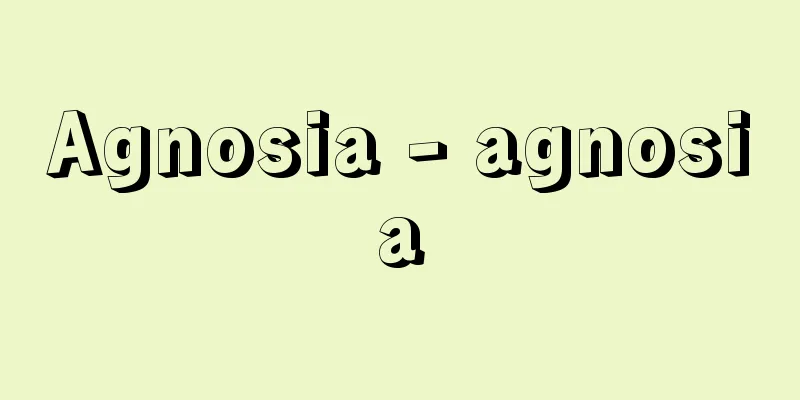Cockroach - Cockroach (English spelling)

|
A general term for insects belonging to the order Blattodea in the class Insecta. Many of them are known as indoor pests. formWithout exception, the body is flat and broad, oval-shaped. Body lengths vary widely, from around 10 mm to over 50 mm. Body color is generally brown or blackish brown, with rare instances of light green or metallic blue-green. The whole body has an oily sheen, which is where the common name aphid comes from. The head is small and points downward, and is mostly hidden under the pronotum. The mouth is biting-shaped, and it often chews things. The compound eyes are bean-shaped but flat. There are two ocelli that are degenerate. The antennae are thread-like and often used as tactile organs, and are long, but those that live in rotting wood, such as the giant cockroach, become relatively short. The pronotum is large and disc-shaped. The forewings are elytate-like, with reticulated veins running through them. The hind wings are folded under the forewings when at rest, but are generally fan-shaped. The degree of degeneration of the wings varies, up to the point where some are completely wingless. All three pairs of legs are walking legs, with rows of sharp spines on the femurs and tibias. The tarsus has five segments. The abdomen is very flat and wide. The telson at the end of the abdomen is segmented, thick and long spindle-shaped, covered with sensory hairs, and functions as the other antenna. The subgenital plate is trapezoidal or semicircular in males, usually with a pair of tail processes, while in females it is smaller, tapers toward the tip, and has no tail processes. The male's external genitalia are asymmetrical. The female's ovipositor is very short, with the end curved downward. [Yamazaki Egane] EcologyOriginally, this group flourished in the tropics, so they prefer warm regions and warm places, and humid places are even more suitable environments for this species. In general, they are strongly nocturnal, tending to be active in the early part of the night. During the day, they hide under bark, under stones, under fallen leaves, between clumps of plant leaves, and in other dimly lit areas. Pest species tend to be gregarious, and the higher the colony density, the faster they grow and the more pest they become. This is due to the effect of aggregation pheromones. They are agile, quickly detecting movement and running. They sometimes fly. They are skilled at getting into narrow spaces, and act by using their thiglottaxis. They are omnivorous, and wood-eating species such as the giant cockroach have flagellates living in their digestive tracts, which digest cellulose. Mating takes place after touching with antennae or a sort of display, but in the German cockroach, the male raises his forewings and lures the female with secretions from the luring glands on the seventh and eighth abdominal tergite, and copulation takes place while the female is licking the secretions. The female creates an egg case in which she lays 30 to 40 oblong eggs, and in the German cockroach, she walks around with the egg case attached to the tip of her abdomen until the eggs hatch, which can be considered a kind of child-rearing. Some species are ovoviviparous. Metamorphosis is incomplete. [Yamazaki Egane] ClassificationThere are over 3,500 known species in the world, with about 50 species in Japan across 8 families. Of these, there are about 30 species of cockroaches that invade human homes, and while they are more prevalent in tropical regions, those that can also be found in temperate regions include the German cockroach, the domestic cockroach, the spotted cockroach, the Smoky brown cockroach, the American cockroach, the Ogasawara cockroach, and the Oriental cockroach. All of these species have been introduced from abroad, and their exact place of origin is unknown. The Yamato cockroach, found only on Honshu, is a species endemic to Japan and is often found in the kitchens of homes in urban and rural areas. These species that invade homes are classified as nuisance pests, as they are the most unpleasant of all sanitary pests. There are also many wild cockroaches, which live mainly in forests. [Yamazaki Egane] systemThis is a group of so-called orthopterous insects, and is one of the oldest groups of insects. The ancestor group is said to have been very prosperous during the Carboniferous period of the Paleozoic era, and there are many fossils of them. Among living insects, the praying mantises are the closest relatives, and the two groups are often lumped together in the Dictuoptera order, but in recent phylogenetic studies, it is common to separate them into the Blattophila and Mantodea orders. [Yamazaki Egane] Cockroach ExterminationThe first step in exterminating cockroaches is to avoid creating gaps that cockroaches can get into, and to always put food and food scraps and other rubbish into containers with lids. Seal gaps with tape or something similar. It is also effective to place rags soaked in vinegar in places where cockroaches are likely to appear. Low-toxicity organophosphate agents (such as DDVP) and poisons (such as Dipterex and boric acid) are used as pesticides. [Yamazaki Egane] FolkloreIt is named after the fact that it bites on wooden bowls. In the local dialect, it is also called gokikurai-mushi (goki-eating insect). In Tokyo and other areas, it is called aphimushi. In the Edo period, people who leeched off people for free were called "aburamushi" (oil bugs) in comparison to cockroaches, but Yokoi Yayu's "Uzuragoromo" (1787) says that oil bugs are not hated, but people are, so cockroaches were not hated that much. In Akita Prefecture, cockroaches in the kitchen are called kamadomushi (cabbage mushi) and should not be exterminated or tampered with. Similar ideas exist in Europe, and in Russia and France, cockroaches are said to be guardian spirits, and having one in the house is a sign of good luck, and their disappearance is a sign of bad luck. Cockroaches are generally seen as demonic, and in Ireland it is said that witches bring plague in the form of cockroaches, while in England there is a story that cockroaches multiply inside people's bodies after they have been swallowed. There are also many stories of effective methods for exterminating them, and Europeans had customs such as sweeping them away on Good Friday, or impaling them on needles as a warning to others. In Ireland, cockroaches are said to have uncovered the hiding place of Christ, so if you find one, you kill it immediately. In Japan, it is said that cockroaches like to attach to oiled paper, and a known method was to place an old umbrella over it to collect cockroaches and then throw them away. [Yo Kojima] Source: Shogakukan Encyclopedia Nipponica About Encyclopedia Nipponica Information | Legend |
|
昆虫綱ゴキブリ目Blattodeaに属する昆虫の総称。室内害虫として知られるものも多い。 形態体は例外がなく扁平(へんぺい)、幅広い体形で小判形。体長は10ミリメートルほどのものから50ミリメートルを超えるものまで変化に富む。体色はおおむね茶褐色ないし黒褐色系の体色で、まれに淡緑色や金属青緑色をもつものもある。全体に油を塗ったようなつやがあり、これが俗称アブラムシの由来である。頭部は下方に向いて小さく、前胸背板下にほとんど隠される。口はかむ型で、ものをよくかじる。複眼はソラマメ状であるが平たい。単眼は退化的なものが2個ある。触角は糸状で、触覚器官としてよく用い、長いが、オオゴキブリのように朽ち木中にすむものは比較的短くなる。前胸背板は円盤状で大きい。前翅(ぜんし)は鞘翅(しょうし)状で、細かい翅脈が多数走る網状脈をもつ。後翅は、静止時には前翅下に畳まれて収められているが、おおむね扇形。はねの退化の程度は、まったく無翅になるものまでいろいろ。脚(あし)は3対とも歩行肢(し)で、腿節(たいせつ)、脛節(けいせつ)には鋭い棘(とげ)を列生する。跗節(ふせつ)は5節。腹部は非常に平たく、しかも幅広い。腹端部の尾角(びかく)は分節し、太くて長紡錘形で、感覚毛が生え、もう一方の触角の働きをしている。亜生殖板は、雄では台形ないし半円形で、普通1対の尾突起がつき、雌ではより小さく、先端に向かって細くなり、尾突起はない。雄の外部生殖器は不相称。雌の産卵管はきわめて短く、端は下方に曲がる。 [山崎柄根] 生態本来、熱帯に栄えたグループのため、暖かい地方、暖かい場所を好み、さらに湿気の多いところであれば、この類にはより好適な環境となる。一般に夜行性が強く、夜間の前半に活動する傾向がある。日中は樹皮下、石の下、落ち葉の下、植物葉の群がりの間、そのほか薄暗い物陰などに隠れている。害虫化している種では群集性が強く、群集密度が高くなるほど成長速度が速く、害虫の度合いが強くなる。これは集合フェロモンの効果による。行動は敏捷(びんしょう)で、物の動きをいち早く察知して走行する。ときには飛ぶこともある。狭いところに入り込むのが巧みで、走触性の習性を働かせて行動する。食性は雑食性で、木材食のオオゴキブリのようなものは、消化管中に鞭毛虫(べんもうちゅう)を宿らせ、この虫によってセルロースを消化させる。交尾は触角で触れ合ったり、一種のディスプレーのあとに行われるが、チャバネゴキブリでは前翅を立てて、第7、第8腹部背板にある誘惑腺(せん)からの分泌物で雌を誘い、雌がその分泌物をなめている間に交尾を行う。雌は卵鞘(らんしょう)をつくって、その中に30~40の縦長の卵を産み付けるが、チャバネゴキブリでは孵化(ふか)するまでこの卵鞘を腹端につけて歩き回り、これは一種の保育と考えられる。卵胎生を行う種もある。変態は不完全である。 [山崎柄根] 分類世界に3500種以上が知られ、日本産のものは8科約50種である。そのうち、人家に侵入するゴキブリの種は約30種であって、熱帯地方に多いが、温帯地方にもみられるものはチャバネゴキブリ、イエゴキブリ、マダラゴキブリ、クロゴキブリ、ワモンゴキブリ、オガサワラゴキブリ、トウヨウゴキブリなどがある。これらはいずれも外国から侵入したもので、その原産地は正確にはわからない。本州のみに分布するヤマトゴキブリは日本の固有種で、都市部や農村の家庭の台所によくみられる。これら家屋に侵入するものは、衛生害虫のなかでも不快さのみが強調される虫なので、不快害虫としてまとめられる。野生のゴキブリも多く、おもに森林中にすむ。 [山崎柄根] 系統いわゆる直翅系の昆虫の一群で、昆虫類のうちでもっとも古い群の一つである。祖先群は古生代石炭紀のころに非常に繁栄していたらしく、化石も多い。現生のもののなかではカマキリ類がもっとも類縁が近く、しばしば両群をまとめて網翅目Dictuopteraとすることがあるが、最近の系統学ではゴキブリ目とカマキリ目とに分けるのが一般的である。 [山崎柄根] ゴキブリの駆除ゴキブリの入り込みそうなすきまをつくらないことと、食物や食物かすのようなごみなどは、かならず蓋(ふた)のある容器に入れることが、駆除の第一条件である。すきまはテープなどでふさぐ。酢を含んだ布きれなどをゴキブリが出現しやすいところに置いておくのも効果がある。薬剤では低毒性の有機リン剤(DDVPなど)、毒剤(ディプテレックス、ホウ酸など)が用いられる。 [山崎柄根] 民俗御器(ごき)(木製の椀(わん))をかじるのでこの名がある。方言にはゴキクライムシ(御器食らい虫)の称もある。東京などではアブラムシといった。江戸時代、人に何かをただでたかる者をゴキブリに例えて「油虫(あぶらむし)」とよんだが、横井也有(やゆう)の『鶉衣(うずらごろも)』(1787)には、油虫は、虫は憎まれず、人は嫌われるとあるから、ゴキブリはそれほど嫌がられたわけでもないらしい。秋田県では、台所にいるゴキブリをカマドムシといい、駆除したり、いたずらしてはならないという。類似の観念はヨーロッパにもあり、ロシアやフランスにはゴキブリを守護霊とし、家の中にいるのは幸運のしるし、いなくなるのは不運の前兆であるとする伝えもあった。一般には悪魔的にみられ、アイルランドでは魔女がゴキブリの姿で疫病をもたらすといい、イギリスには人が飲み込んだゴキブリが体内で繁殖したという話がある。効果的な駆除法の伝えも多く、ヨーロッパ人の間には、聖金曜日に掃き出すとか、見せしめに針に突き刺すなどの習俗があった。アイルランドではゴキブリはキリストの隠れている場所を暴いたと伝え、みつけるとすぐに殺す。日本ではゴキブリは油紙に好んでつくといい、古い傘を置いてゴキブリを集めて捨てる方法が知られていた。 [小島瓔] 出典 小学館 日本大百科全書(ニッポニカ)日本大百科全書(ニッポニカ)について 情報 | 凡例 |
Recommend
Franchisee
...It is also characteristic of Japan that franch...
Norimichi Inaba
1603-1648 A daimyo in the early Edo period. Born ...
Wu Yue - Goetsu
The states of Wu and Yue in the Spring and Autumn ...
Carbon dioxide - Nisankatanso (English spelling)
A gas produced during the complete combustion of ...
Chestnut moth - Cydia kurokoi
A species of the Lepidoptera, Tortricidae family. ...
Kita Shichidayu Muneyosi
1651-1731 A shite (Noh actor) from the early to m...
Carpophilus delkeskampi (English spelling) Carpophilusdelkeskampi
...There are two pairs of projections on the term...
Pinus palustris (English spelling) Pinuspalustris
… [Makoto Nishida]. … *Some of the terminology th...
Fribourg - Fribourg (English spelling)
The capital of the canton of Fribourg in western ...
Resident servant - Igeshihokounin
… [Kitahara Akio] [Rural Servant] Servants in ear...
Nguyen Sieu - Nguyen Sieu
... Shortly after the death of Ngo Quyen, local l...
Fune no Ezaka
Year of birth: Unknown A man who served the Yamato...
History of Goryeo (English: Koryō-sa)
A historical record of the Goryeo Dynasty of Korea...
Kizo's Garden - Kimi no Niwa
The title of a Nagauta song. It was announced at t...
Poet Laureate
A title of honorary poet in England. Since the Mi...







![Paraná [river] - Paraná](/upload/images/67cc8f9fbd6e4.webp)

